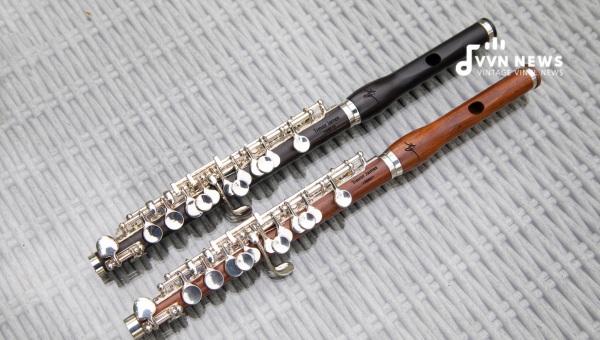If you’re a flute player looking to take your skills to the next level, you might be wondering how to upgrade your flute?
Upgrading your flute can have a significant impact on your playing experience, allowing you to produce a richer, more resonant sound.
In this article, I will guide you through the process of upgrading your flute, from determining if it’s worth upgrading to choosing the right flute for your needs.
So, if you’re ready to enhance your musical journey, let’s explore how to upgrade your flute!
When it comes to upgrading your flute, there are several factors to consider. First and foremost, you’ll need to assess whether or not it’s worth investing in an upgrade.
If you’ve been playing a student-level instrument for some time and feel limited by its capabilities, upgrading can be a game-changer for your musical progression.
Upgrading allows you access to higher-quality materials and craftsmanship that can greatly enhance your sound and playability.
How to Upgrade Your Flute?
As a flute player, upgrading your instrument can have a profound impact on your playing experience.
Whether you’re a beginner looking to step up from a student-level flute or an advanced player seeking greater tonal richness and versatility, upgrading your flute is a worthwhile investment.
We will explore different upgrade options and guide you through the process of choosing the right flute upgrades for your needs.
Key Factors to Consider Before Upgrading
Before diving into specific upgrade options, it’s important to consider the following factors:
- Skill Level: Assess where you are in your musical journey. If you’re an intermediate or advanced player, upgrading to a higher-quality flute might be more beneficial.
- Budget: Determine how much you’re willing to invest in an upgraded flute. Flute prices can vary greatly based on materials and craftsmanship.
- Playing Style: Consider the type of music you enjoy playing and whether specific upgrades align with your musical preferences.
- Long-Term Goals: Think about where you see yourself as a flutist in the future. Upgrading to a more professional-level instrument can help support your aspirations.
Also Read: 11 Best Beginner Flute Books [Start Your Melodic Journey Right]
Upgrade Options
When considering a flute upgrade, several key components come into play:
1. Solid Silver Head Joint
The head joint is one of the most crucial parts of the flute, directly affecting tone production and response. Upgrading to a solid silver head joint can provide enhanced projection and tonal flexibility compared to standard nickel-silver head joints.
2. Silver Plated or Solid Silver Body
The body of the flute contributes significantly to its overall sound quality. Upgrading to either a silver-plated or solid silver body can enhance tonal richness by adding warmth and depth.
3. Open Holes
Open-hole flutes feature keys with uncovered holes instead of closed keys found on beginner-level flutes. Open-hole flutes allow for greater control over pitch and tone, as well as increased versatility in advanced playing techniques.
4. Inline/Offset G
The placement of the G key (the third finger key) can vary on flutes. Inline G flutes have the G key in line with other keys, while offset G flutes have a slightly different positioning. Test both options to determine your preference and which one feels more natural and comfortable to play.
5. B Foot Joint
The foot joint of a flute comes in different lengths: C, B, and sometimes even a longer Bb foot joint. Upgrading to a flute with a B foot joint extends the range of your instrument by a semitone, allowing you to play more repertoire that requires the lower B note.
What Are the Key Factors to Consider Before Upgrading?

Before embarking on an upgrade journey for your flute, it’s essential to consider several key factors that will help you make an informed decision.
These factors will enable you to choose the right upgrades that align with your skill level, musical goals, and budget. Let’s dive into the details:
Skill Level
Evaluate your current skill level as a flutist. If you’re a beginner or at an intermediate level, it might be more practical to focus on improving your technique before considering an upgrade.
However, if you’re an advanced player looking for more tonal richness or specific features, upgrading your flute could greatly enhance your playing experience.
Budget
Determine how much you’re willing to invest in upgrading your flute. Flute prices can vary significantly depending on the quality of materials and craftsmanship. Set a realistic budget range that aligns with your financial resources.
Playing Style
Consider the type of music you enjoy playing. Different flute upgrades cater to various musical styles and preferences. For example, if you primarily play classical music, certain upgrades may provide more tonal depth and projection suitable for that genre.
Long-Term Goals
Think about where you see yourself as a flutist in the future. If you have aspirations of performing professionally or pursuing higher-level musical education, investing in a more professional-grade instrument might be beneficial in supporting those goals.
Try Before You Buy
Before making any final decisions, try out different flutes with the desired upgrades whenever possible.
Testing different options will allow you to assess their playability, tone quality, and feel in order to make a well-informed choice.
By considering these key factors before upgrading your flute, you’ll be equipped with valuable insights that will guide you toward choosing the right upgrades that enhance your musical journey.
Also Read: How To Structure The First Flute Lesson? [Expert Advice]
How to Choose the Right Flute Upgrade Option?
Choosing the right flute upgrade option can seem overwhelming with all the choices available. However, by considering a few key factors and understanding your specific needs, you can make an informed decision. Here’s a step-by-step guide to help you choose the right flute upgrade:
- Evaluate Your Playing Style: Consider the type of music you play and your preferred sound. If you primarily play classical music, a solid silver head joint and body may be ideal for achieving a warm and rich tone. If you play jazz or contemporary genres, a silver-plated flute with open holes could offer more versatility.
- Set Your Budget: Determine how much you’re willing to spend on an upgrade. Keep in mind that higher-quality materials and craftsmanship often come at a higher cost. Research different brands and models within your budget range to find the best value for money.
- Try Before You Buy: Visit a reputable flute dealer or attend flute conventions where you can try different flutes before making a decision. Pay attention to how each flute feels in your hands, as comfort is crucial for optimal playing.
- Seek Professional Advice: Consult with professional flutists, teachers, or trusted experts who can provide guidance based on their experience. They can help identify specific features that may suit your playing style and suggest reputable brands known for their quality.
- Consider Trade-Ins or Upgrades from Authorized Dealers: Some dealers offer trade-ins, allowing you to exchange your current flute for credit towards an upgrade purchase. This option can help offset some of the costs.
- Research Warranties and After-Sales Services: Look into the warranty offered by the manufacturer or dealer for upgraded flutes. A good warranty ensures peace of mind in case of any manufacturing defects or issues that may arise after purchase.
Upgrading your flute is a personal choice based on individual preferences. Take your time, do thorough research, and experiment with different options until you find the flute upgrade that aligns with your musical goals and aspirations.
Step-by-Step Guide to Upgrading Your Flute

Upgrading your flute requires careful consideration and some research to ensure you make the right choice. Follow this step-by-step guide to navigate the process:
Determine Your Budget
Start by setting your budget for the flute upgrade. Determine how much you’re willing to invest in your instrument while keeping in mind that higher-quality flutes often come with a higher price tag.
Research and Compare Options
Research different flute models that align with your budget and playing preferences. Read online reviews, watch video demonstrations, and consult with fellow flutists or music instructors. Make a list of potential flute upgrades.
Test Play Flutes
Visit your local music store or attend flute expos where you can try out different instruments. Take note of how each flute feels, sounds, and responds to your playing style. Consider factors such as tone quality, intonation, and ergonomics.
Consult with Professionals
Seek advice from professional flutists or music educators who have experience with various flute brands and models. They can offer valuable insights into the pros and cons of specific upgrades based on their own experiences.
Visit Multiple Stores
If possible, visit multiple stores to increase your options for testing different flutes. Each store may have a slightly different selection of brands and models available.
Consider Trade-In or Used Instruments
Check if any music stores offer trade-in options for your current flute when purchasing an upgrade. Additionally, explore the possibility of purchasing a used instrument from a reputable seller – this can be a cost-effective way to obtain a high-quality instrument.
Make Your Selection
After gathering all the information, trying out various flutes, and considering factors like sound quality, playability, and budget constraints, make an informed decision on which flute upgrade suits you best.
Take Care of Your New Flute
Once you’ve purchased your new flute, it’s crucial to take proper care of it. Clean and store the instrument properly, follow maintenance instructions, and have it serviced regularly to ensure its longevity and optimal performance.
Upgrading your flute is an exciting step in your musical journey. By following these steps and carefully considering your options, you’ll be well on your way to finding the perfect flute upgrade that enhances your playing experience and takes your music to new heights.
Also Read: 12 Tips To Improve Your Low Notes On The Flute [Easy Strategies To Learn]
Tips for Maximizing the Performance of Your Upgraded Flute
Congratulations on upgrading your flute! Now that you have a higher-quality instrument, it’s essential to care for it properly and optimize its performance. Here are some valuable tips to help you get the most out of your upgraded flute:
Regular Maintenance
Keep your flute in excellent condition by maintaining a regular cleaning schedule. Use a clean, lint-free cloth to wipe away fingerprints and moisture after each playing session. Additionally, have your flute professionally serviced at least once a year to ensure all mechanisms are properly adjusted.
Proper Storage
When not in use, store your flute in a protective case to prevent dust and damage. Avoid exposing it to extreme temperatures or humidity, as this can impact its performance and durability.
Consistent Practice
To maximize the potential of your upgraded flute, consistent practice is key. Set aside dedicated practice time each day to improve your technique and explore the full range of your instrument’s capabilities.
Experiment with Different Head Joint Positions
The position of the head joint within the crown cork can affect tone and response. Experiment with small adjustments in positioning (e.g., pulling it slightly out or pushing it further in) to find the sweet spot that produces the desired sound quality.
Explore Different Articulation Techniques
With an upgraded flute, you may find increased responsiveness in articulation techniques such as staccato or legato playing. Experiment with different tongue placements and speeds to achieve desired articulation effects.
Incorporate Vibrato Techniques
Experimenting with vibrato can add depth and expression to your playing. Develop control over vibrato speed, width, and character by practicing various methods such as diaphragmatic or hand vibrato.
Seek Guidance from a Teacher or Mentor
Working with a skilled flute teacher or mentor can provide invaluable guidance in maximizing your flute’s performance. They can offer technical advice, help you explore new musical techniques, and offer insights into repertoire selection.
Explore Different Repertoire
Your upgraded flute opens up new possibilities in terms of tonal colors and dynamic range. Push the boundaries of your musical exploration by diversifying your repertoire, and exploring different genres and styles.
By following these tips, you’ll be able to fully optimize the performance of your upgraded flute and unlock its full potential. Enjoy the journey of exploring new musical horizons with your enhanced instrument.
FAQs About Upgrading Flute
What is the benefit of upgrading to a solid silver head joint?
Upgrading to a solid silver head joint can provide greater projection and tonal flexibility, resulting in a richer and more resonant sound.
How does upgrading to a silver-plated or solid silver body improve the flute’s sound quality?
A silver-plated or solid silver body enhances tonal richness by adding warmth and depth to the overall sound of the flute.
What advantages do open-hole flutes offer over closed-hole flutes?
A3: Open-hole flutes allow for greater control over pitch and tone, as well as increased versatility in advanced playing techniques.
Q4: What is the difference between an inline G and offset G flute?
Inline G flutes have the G key in line with other keys, while offset G flutes have a slightly different positioning. The choice depends on personal preference and comfort in finger placement.
How does upgrading to a B foot joint expand the range of the flute?
Upgrading to a B foot joint extends the range of your instrument by enabling you to play a lower B note, opening up more repertoire possibilities that require that pitch.
Conclusion
Upgrading your flute can greatly enhance your playing experience and unlock new possibilities in your musical journey.
By considering key factors such as skill level, budget, playing style, and long-term goals, you can make an informed decision on the flute upgrades that best suit your needs.
Whether it’s investing in a solid silver head joint for enhanced tonal flexibility or opting for open holes and a B foot joint for expanded range and versatility, upgrading your flute will take your musical expression to new heights.
Start exploring the world of flute upgrades today and enjoy the benefits of a higher-quality instrument.








